
This page is one small part of Good Sites for Kids!
Now with a Morse Code and Cryptology section!
Look
for ![]() to
see what's been added lately!
to
see what's been added lately!
Some of the descriptions on this page are a bit long. They have to be, to describe the technology involved.
3
Perfect Papercraft Projects for beginners - a video episode from Sylvia's
Super Awesome Maker Show!
"On this episode we’ll be taking a look at the incredibly
popular craft that everyone is into! No, not Minecraft... Papercraft!
I'll be showing you how to make three perfect papercraft projects for beginners:
A 3D folded Minecraft avatar,
colorful swirly paper, and hopping origami paper froggies! Lets go!" It's
fun and you can't beat her enthusiasm!
5 Unbeatable Reasons Your Kid Should Be Coding

"Coding empowers kids to communicate with the machines and acquire
the ability to turn
creativity into interactive reality. The computer language like any other language
is best
learnt at a young age. If you want your kids to crack complicated problems through
logical
reasoning, introduce them to the world of coding early on. Kodable
made this infographic
which illustrates how introducing programming to kids at an early age can help
them in
many different ways."
![]()
5 Cool Virtual Lab Experiments You Can Try Right Now
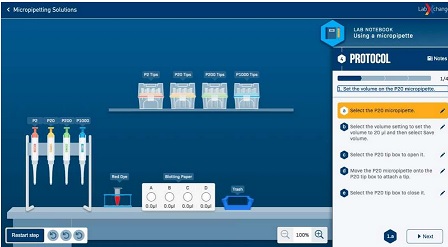
"With schools, universities, and museums socially distanced or
fully online, there are fewer opportunities than usual to experience
science experiments and demos. But LabXchange has you covered.
This free platform features all kinds of science content, including
virtual lab experiments and other interactive experiences."
![]()
12
Marvelous Warrior Armor Ensembles from History
You Should Know About from Realm
of History
From 3,500 year old Bronze Age armor to Polish Winged Hussars
from the 1600s. Lavishly illustrated with descriptions of the armor.
Also includes Aztec, Japanese, Mongol, and Persian armor.
19 Free Resources to Learn Computer Science, Programming and Coding from Happy Trails Wild Tales "Computer Science, Programming and Coding is fast becoming a fun and functional skill in today’s technological world. Lucky for us, there is no shortage of free resources for those who’d like to learn and brush up on these skills. I’ve compiled, here, a list of 19 resources for you life-long learners to embark on a journey of learning to code!" Names, links, and information about 19 online places learners can learn coding for free! Read over them and click what looks good to you. Candy Cook, author of this blog, "is Georgia’s Official Outdoors Explorer and a devoted homeschooling mom." Looks like a great resource.
128,000
Dominoes Falling into past a journey around the world. 7:12 video follows
the whole event as a gym full of dominos follow their paths. They transform
art, move objects, drop a 30 meter long wall, and generally act like kinetic
art.
This is fun to watch, and the crowd goes wild!
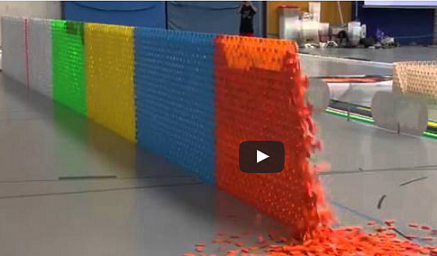
360° Panorama of London "The 320 gigapixel image - taken by expert photography firm 360Cities – comprises 48,640 individual frames which have been collated into a single panorama by a supercomputer." Taken from atop a very tall skyscraper, you see everything for many kilometres (or miles) in all directions! There are about eight million people in London, and you probably see most of them.
2,000 year old sock from Egypt
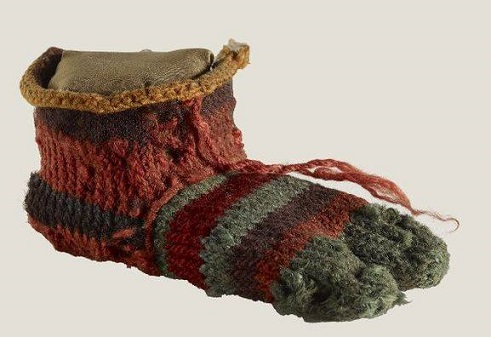
Nålebinding
("single needle knitting") is an ancestor of knitting.
Viking crafters were very big on this style. This child's sock is
from ancient Egypt, in Coptic style; wonderful how it has kept
its colors! Coptic Christians of Roman Egypt liked to make a
separate pouch for the big toe.
Japanese work boots still have them today.
Featuring Primitive Pete!
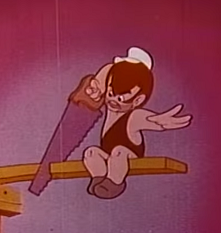 The
ABCs of Hand Tools ~ A Health and Safety Lesson produced by Walt Disney
for General Motors in 1945. 30+ minutes, with a transition break at about 17
minutes, if you want to break it into sections. Timeless lessons on the proper
use and care of traditional hand tools. Includes such mundane items as hammers
and screwdrivers. Common hand tools are still in use, so the hard-learned knowledge
passed on in this old film is still important today. There's only one way to
hammer a nail, for example. The old craftsmen had these things figured out precisely,
so follow their guidance and avoid reinventing the wheel. Copied from a 35mm
film and glitchy/jigggly at both ends. Does not cover power tools.
Does cover traditional hand woodworking tools.
The
ABCs of Hand Tools ~ A Health and Safety Lesson produced by Walt Disney
for General Motors in 1945. 30+ minutes, with a transition break at about 17
minutes, if you want to break it into sections. Timeless lessons on the proper
use and care of traditional hand tools. Includes such mundane items as hammers
and screwdrivers. Common hand tools are still in use, so the hard-learned knowledge
passed on in this old film is still important today. There's only one way to
hammer a nail, for example. The old craftsmen had these things figured out precisely,
so follow their guidance and avoid reinventing the wheel. Copied from a 35mm
film and glitchy/jigggly at both ends. Does not cover power tools.
Does cover traditional hand woodworking tools.
Actionbits "Action Bits is a series of in-depth technology skills classes developed by a team of professionals — experienced teachers & veterans of the high-tech industry — committed to teaching kids the computer skills they will need to excel in school...and beyond!"Parts of this site require a login, which you may get upon request. Besides tech modules, Lynne's Library features many elementary through high school links to some very good math, language arts, science, health and other ed sites. Pretty cool.
![]() Activity
TV This truly excellent
site has at least a couple of hundred good instructional videos on subjects
like paper airplanes, science projects, magic, making jewelry, crafts, origami,
juggling, cheerleading, cooking (!), and more! It also has Lego action videos
and several good games! The videos are really world-class, with adult instruction,
printable parts lists, and recipes. Projects on the videos can be accessed by
skill levels, categories, most viewed, etc. You need
to look at Activity TV!
Activity
TV This truly excellent
site has at least a couple of hundred good instructional videos on subjects
like paper airplanes, science projects, magic, making jewelry, crafts, origami,
juggling, cheerleading, cooking (!), and more! It also has Lego action videos
and several good games! The videos are really world-class, with adult instruction,
printable parts lists, and recipes. Projects on the videos can be accessed by
skill levels, categories, most viewed, etc. You need
to look at Activity TV!
Anatomy of a Refrigerator "You likely have one, but do you know how it works?" Find out at this interactive site!
Ancient Coliseum: A Virtual reality experience with Oculus Rift This 5 minute video concentrates on the atmosphere of structure and the place. The Coliseum was designed to impress the audience with its incredible awesomeness. The sound of the audience adds to the ambience.
Some sites about aqueducts:
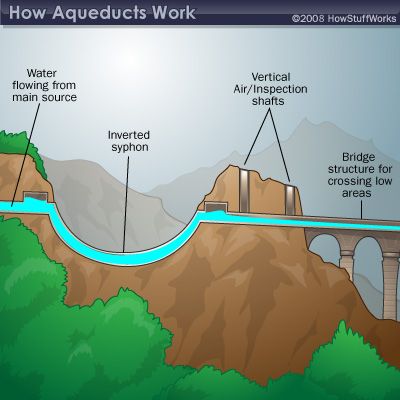
How a Roman Aqueduct Works This site is a one page overview of aqueducts. People had to find ways to bring water to where they lived. Romans, with their engineering genius, overcame their water problems with aqueducts. Tunnels, bridges for the water, inverted siphons to pull water uphill, dams, distribution tanks and conduits to carry water all over the city, all these things took skill to design and build.
Roman Aqueducts "This website on Roman aqueducts aims to show what marvelous work has been done by engineers and architects of the Roman empire." This is a multipage, graphic-intensive site with all the data you could ever want. Drawings, photos, facts, even slideshows.
Qanats The aqueducts of the Middle East. Underground tunnels to carry water. Romans used them as part of their aqueduct systems. They are still in use in Iran and some other places in the Middle East, and in western China. "There are significant advantages to a qanat water delivery system including: (1) putting the majority of the channel underground reduces water loss from seepage and evaporation; (2) since the system is fed entirely by gravity, the need for pumps is eliminated; and (3) it exploits groundwater as a renewable resource."
No mystery here! It's a puquio, the New World version of a
quanat. Similar to the ones in the Middle East and Asia because
there's only one way to let gravity move large amounts of water
underground. Today we use big underground pipes. In ancient times
they had to dig tunnels using hand tools. The holes oxygenate the
water and give access to the quanat. The New World versions,
(puquios) have exotic spiraled access holes, the better to channel
winds into the canals.
![]() Balloons and Static
Electricity Another interactive science simulation from PhET.
"Why does a balloon stick to your sweater? Rub a balloon on a sweater,
then let go of the balloon and it flies over and sticks to the sweater. View
the charges in the sweater, balloons, and the wall."
Balloons and Static
Electricity Another interactive science simulation from PhET.
"Why does a balloon stick to your sweater? Rub a balloon on a sweater,
then let go of the balloon and it flies over and sticks to the sweater. View
the charges in the sweater, balloons, and the wall."
Best Alternatives to PowerPoint from SlideShare. "Let’s face it: PowerPoint isn’t the easiest to learn and use, especially if you’re wanting to elevate your design beyond headers and bullet points. Thankfully there are other tools available today that allow you to easily create presentations — and have them look good, too." Lists and discusses the Pros and Cons of five alternatives. Two are for MacOS only. Worth reading before you decide what to go with for presentations. Also, have a look at SlideShare, which has a pretty respectable suite of its own.
Blow the Ballast! from the Office of Naval Research, USN, has a history of submarines (including the rescue of the USS Squalus), how submarines work, and a section on people under the sea.
Blue Origin Crew Capsule Escape Test Goes Flawlessly The latest private attempt at operating a space vehicle is testing a brand new escape capsule! This eight-minute video covers most of the original movie and is much less complicated for munchkins. The new capsule concept is explained, too. "The private spaceflight company's New Shepard rocket and its capsule were both returned to ground after a successful test of its In-flight Escape system. An engine aboard the capsule blasted it away from rocket 45 seconds after launch."
Bridge Building Contests We've seen some great popsicle stick bridges made by students over the years. Usually this involves how much weight the bridge can bear. These contests teach the value of following precise directions ( kids need more practice at this skill), as well as precise measurements. If you need help organizing one of these, here are some sites to get you started. Here is a typical bridge contest site. Here is a how-to site with examples. Here is a site with techniques and pointers. Thanks Steve K. for this idea.
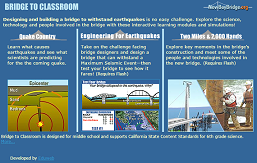 Bridge
to Classroom "Designing and building a bridge to withstand earthquakes
is no easy challenge. Explore the science, technology and people involved in
the bridge with these interactive learning modules and simulations!" This
has its own page on GSFK!
Bridge
to Classroom "Designing and building a bridge to withstand earthquakes
is no easy challenge. Explore the science, technology and people involved in
the bridge with these interactive learning modules and simulations!" This
has its own page on GSFK!
Camera in the dishwasher (As submitted to ScienceDump. This was on YouTube first, and is also up on AsapScience.) "Always wanted to see what happens in your dishwasher after you close the door? Now is your chance. Bito has created a video showcasing a full wash cycle inside a dishwasher using a GoPro Hero3 camera." "Always wanted to see what happens in my dishwasher after I close the door. Many of the other videos I saw had terrible lighting or bad angles." Watch it, and you'll gain an appreciation for the technology designed into a dishwasher. Someone, or some group, had to visualize this from nothing and then design it. As with any other form of human activity, this can be learned. Text descriptions of what is happening are in the video. It's set to music, too.
Camp H - Building Camp for Girls. It's an innovative after-school and summer design and build camp for 9- to 12-year-old girls, offering girls practical creative and problem-solving skills. "I want to teach them how to weld, to work on projects that don’t feel artsy and craftsy... to balance the creative and the artistic side... to use hand and power tools, basic electrical equipment and automotive instruments to fix the things that need repair, installation, and maintenance in our everyday lives. Coupled with core-subject math and science concepts, we will tinker, experiment, build, and repair.” Camp H is one of three programs that together make up Project H . Studio H is an in-school design/build class for 8th-11th grade students that sparks community development through real-world, built projects. Workshop H, creative "boot-camp" training customized for teachers, leaders, and organizations, is outside the scope of GSFK. Project H's Toolbox section holds their entire FREE five years of lesson plans, activities, project briefs, and resources used in the Studio H and Camp H programs. Credit to Kristin Hohenadel for her Slate article describing Camp H. Kudos to Emily Pilloton for starting this whole thing!
CardKiwi "Create flashcards together with your friends and save a ton of time! Our algorithm increases retention up to 50%" Everyone has made flashcards to study. With CardKiwi you can do it online! Think of the advantages! The principle of Spaced Repetition is the key. "The application is so simple to use, we even have kids in grade 2 using it." Free Technology for Teachers (a great blog, btw) gives more details: “Card Kiwi is a flashcard service whose appeal is its simplicity. Flashcards on Card Kiwi are text only. As you flip through your flashcards you rate your understanding by simply clicking thumbs up, thumbs down, or thumbs sideways. Card Kiwi will show you the cards that you rate with a thumbs down or thumbs sideways more often than the others until you're using the thumbs up on every card in your set.” Wikipedia article excerpt: "Several students can... collaborate on the same set of flashcards in realtime." Thanks, Michael Bollinger, for the timely email about this most impressive site.
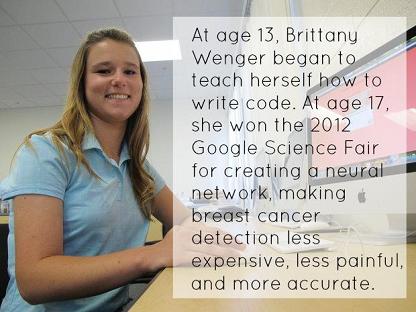
Her project name is Global
Neural Network Cloud Service for Breast Cancer.
Here is the input form for biopsies.
"The current network is 99.11% sensitive to malignancy
(after) 7.6 million trials." Ms. Wenger wants to improve upon this 99.1%
accuracy.
Wonderful! GSFK will always feature stories about students like her!
Castles on the Web "offers an extensive database of all things Castle related including a castle photo gallery, free castle web pages, hundreds of castle links, castle site of the day, castles for kids and more!" A window on medieval construction that has lasted centuries. For our favorite trio of 10 year old castle freaks, and a few hundred thousand more like them. It's a window on medieval construction techniques that have lasted centuries.
![]() CODE
"Every student in every school should have the opportunity to learn to
code." So say Bill Gates, Mark Zuckerberg, President Bill Clinton, Senator
Marco Rubio (R) - Florida, Senator John Thune (R) - South Dakota, Stephen Hawking,
Sheryl Sandberg, Vice President Al Gore, Richard Branson, Ashton Kutcher, Dr.
Oz, Arianna Huffington, NYC Mayor Mike Bloomberg, Eric Schmidt - Google, Randi
Weingarten - AFT, Wendy Kopp - Teach For America, Steve Ballmer - Microsoft,
Governor John Hickenlooper of Colorado, Enrique Iglesias, Snoop Dogg, Reid Hoffman
- LinkedIn, Dick Costolo & Jack Dorsey - Twitter, Governor Jay Inslee of
Washington State, Max Levchin - Paypal, Dara Khosrowshahi - Expedia, Gabe Newell
- Valve, Yishan Wong - Reddit, Salman Khan, and many others. Read what they
have to say.
CODE
"Every student in every school should have the opportunity to learn to
code." So say Bill Gates, Mark Zuckerberg, President Bill Clinton, Senator
Marco Rubio (R) - Florida, Senator John Thune (R) - South Dakota, Stephen Hawking,
Sheryl Sandberg, Vice President Al Gore, Richard Branson, Ashton Kutcher, Dr.
Oz, Arianna Huffington, NYC Mayor Mike Bloomberg, Eric Schmidt - Google, Randi
Weingarten - AFT, Wendy Kopp - Teach For America, Steve Ballmer - Microsoft,
Governor John Hickenlooper of Colorado, Enrique Iglesias, Snoop Dogg, Reid Hoffman
- LinkedIn, Dick Costolo & Jack Dorsey - Twitter, Governor Jay Inslee of
Washington State, Max Levchin - Paypal, Dara Khosrowshahi - Expedia, Gabe Newell
- Valve, Yishan Wong - Reddit, Salman Khan, and many others. Read what they
have to say.
Code.org is a non-profit foundation dedicated to growing computer programming education. Our goals include:
(1) Spreading the word that there is a worldwide shortage of computer programmers, and that it's much easier to learn to program than you think.
(2) Building an authoritative database of all programming schools, whether they are online courses, brick+mortar schools or summer camps.
(3) Our vision is that every student in every school has the opportunity to learn how to code. We believe computer science and computer programming should be part of the core curriculum in education, alongside other science, technology, engineering, and mathematics (STEM) courses, such as biology, physics, chemistry and algebra.
The Learn section has intros to simple programs like Scratch and Karel the Dog. The Teach section has tutorials, curriculum you can integrate into classes, options to bring classes to your school, and more programs like Scratch and Alice to try out.
Bottom line: Business, industry, you name it, they're all screaming for people who can write code. Read the Quotes, like these:
Color Vision and Art This site covers the science behind our color vision as it effects art. (If we did not have color vision, all our art would be grayscale. Ugh.) Interactives and a lot of new-to-us art concepts make this a very enlightening site. Use sliding color bars to see what great paintings look like at different color levels. See how the difference between older and newer parts of the human brain affect how we see Monet's painting. Technical terms explained, too. Learn the technicalities of Peripheral Vision. Decide if Mona Lisa is smiling or not. One of many sites at WebExhibits.


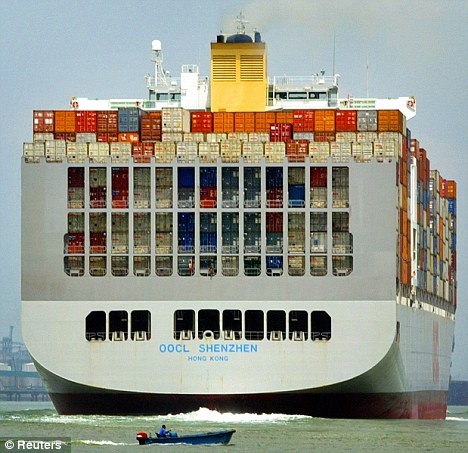

Container ships. In the 1950s, shipping by sea was so complicated and expensive that most companies stayed away from it. The video, and its article and graphics, explains the origins of the container ship and how they drastically changed the world. "Containers can be transported by container ships, trucks, and freight trains as part of a single journey, without unpacking." - Wikipedia. Huge ships carrying hundreds of 40 foot sealed containers lowered the cost of shipping by about 90%. Now it was cheap to get goods to markets on the other side of the world. It was also cheap to buy imported goods. Therefore WalMart and the other "big box" stores with mostly imported goods. Now everybody uses containers. Have a look at these monster ships!
![]()
Easy Unit Converter!
For All Types of Online Calculator & Metric Conversions

The Mother Of All Conversion Sites (MOACS)
This pic conveys the feeling of scrolling through
this page, looking at all the hundreds of formulae.
Fortunately it's well organized!
Cool Zone for Kids from Utility Services of Alaska has a great site about water! The Story of Drinking Water, water FAQs, games, Water Cycleprintables, how water is treated to make it potable, more.
Create
a Car from ABCYa! lets kids build a colorful vehicle to their own
specs. All sorts of wild parts to add. With instructions for adults to read
over. With music.
![]() Cyberchase "an online destination
designed to captivate, entertain, and improve problem-solving and math skills
is now bigger and better than ever!" The Games
section has over 40 good applied math games. The
Science
section has activities plus an outstanding, ongoing series of Cyberchase
Quest games. The technology focused Inventors'
Workshop game is a series of exercises in building machines that work!
Cyberchase "an online destination
designed to captivate, entertain, and improve problem-solving and math skills
is now bigger and better than ever!" The Games
section has over 40 good applied math games. The
Science
section has activities plus an outstanding, ongoing series of Cyberchase
Quest games. The technology focused Inventors'
Workshop game is a series of exercises in building machines that work!
Dawn Spacecraft Begins Approach to Dwarf Planet Ceres from NASA and JPL. NASA's ion-powered Dawn spacecraft has entered an approach phase in which it will continue to close in on Ceres, a Texas-sized dwarf planet never before visited by a spacecraft. Dawn launched in 2007 and is scheduled to enter Ceres orbit in March 2015. Located in the Asteroid Belt, Ceres is round like a planet, not jagged like other asteroids. The included video explains ion engine propulsion, which has already let Dawn slow down to explore Vesta, and then speed up to head for Ceres.
Derinkuyu & The Underground Cities of Cappadocia
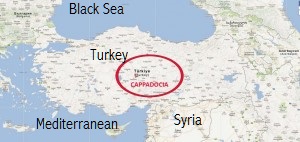
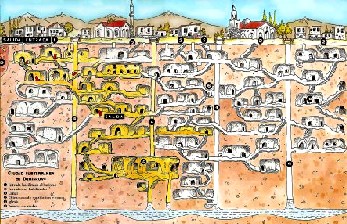
Learn about mysterious ancient underground cities! Located in Turkey, these places were dug in ancient times starting during the time of the Pharaohs of Egypt. Two charts and plenty of photos accompany this page. The architecture, air flow design, and access to underground water are worth your study.
Design Squad Nation from WGBH Boston! "Design Squad Nation is a digital hub for kids, tweens and teens that promotes the message: You are creative and can solve problems. You can make things that help people. You can dream big. Design Squad Nation features include webisodes, hands-on DIY projects, team challenges, contests and an engaged online community. We also have resources, guides and training for parents, educators and engineers..." Featuring FIDGiT a fast-paced action thinking game that you can add onto! "DESIGNiT, BUILDiT, FIDGiT is an exciting puzzle game where you solve challenges and save tiny creatures called Fidgits! Think fast and manipulate blocks, springs, funnels, and other objects to bring the Fidgits home safely.
Features:
GSFK thanks Abbie Steinbacher, Online Community Manager, Children's Programming: Design Squad Nation at WGBH for her email about Design Squad Nation.
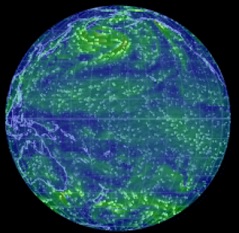 Earth
Wind Map Quoting
Daily
Kos: " ... a new graphical development called the Earth Wind Map has
set a new standard for combining fascinating imagery with (near) real-time wind
information. Check it out and we think you'll agree that the 'wow' factor is
off the chart.
Earth
Wind Map Quoting
Daily
Kos: " ... a new graphical development called the Earth Wind Map has
set a new standard for combining fascinating imagery with (near) real-time wind
information. Check it out and we think you'll agree that the 'wow' factor is
off the chart.
...the interactive map allows users to monitor wind patterns virtually anywhere on earth. The Google Earth-style display lets you adjust the globe's image to pinpoint any spot on the planet. Data is updated every three hours.
While flow patterns indicate wind direction — almost hypnotically — all over the planet, a subtle color scheme indicates wind strength, with gentle breezes represented by thin green lines, stronger winds by bright yellow, and extreme winds by red."
EarthViewer "is a free iPad app that takes you through 4.5 billion years on Earth. EarthViewer allows you to select eons and eras to view. Within each eon and era you can view tectonic plates, continental drift, and other geological events. You can view major biological events in EarthViewer too. Climate data for the last one hundred years is available in the app. EarthViewer users can manipulate the virtual globe to see how each continent has moved and been altered over time." Credit = http://ipadapps4school.com/
 EepyBird
Now with Extreme Sticky Note Experiments, too!
"The Extreme Diet Coke & Mentos Experiments: What happens when you
combine 200 liters of Diet Coke and over 500 Mentos mints? It's amazing and
completely insane." Yes, this is that site you've heard about. Among
other projects, it duplicates many of the famous outdoor water fountains of
Europe using Diet Cokes and Mentos. Lots of streaming videos of it, too. Might
make a neat end of year outdoor science exercise.Thanks
to Sam Fields, high school science teacher in Washington State.
EepyBird
Now with Extreme Sticky Note Experiments, too!
"The Extreme Diet Coke & Mentos Experiments: What happens when you
combine 200 liters of Diet Coke and over 500 Mentos mints? It's amazing and
completely insane." Yes, this is that site you've heard about. Among
other projects, it duplicates many of the famous outdoor water fountains of
Europe using Diet Cokes and Mentos. Lots of streaming videos of it, too. Might
make a neat end of year outdoor science exercise.Thanks
to Sam Fields, high school science teacher in Washington State.
EdHeads! THE primo
kid technology site! Interactive online activities teach about simple machines,
virtual surgery, weather, CSI, designing cell phone, and tons more recently
added. Lesson plans, too!
"Edheads
provides free, educational online games focused on science, math, and critical
thinking. Our activities are designed to meet both state and national standards.
We partner with corporations, universities, and school systems throughout the
United States, which help us research, design, and test our activities every
step of the way. Not only do teachers and students appreciate our free activities,
Edheads has been recognized by almost every major award on the Web for our excellent
educational content. So click the "Choose an Activity" tab at the
top of the page to dive into an activity and let the fun and learning begin!"
Egg Dropping sites Not Egg Drop Soup, we hope! These sites cover organizing your own egg dropping contests, where physics meets engineering, and hopefully the eggs don't smash! An Egg Drop Contest with rules, from Centenary College of Louisiana. The American Association of Physics Teachers had a contest at Six Flags America this year (2014), with the rules online. UC Berkeley has a Junior High Egg Drop Contest with rules, etc. You get the concept. Thanks, teacher "Plet" G. for the inspiration.
![]()
Schoolhouse Rock- Electricity, Electricity

Timeless musical cartoon video explains electricity,
including generation, power lines, volts, and watts.
Also playing with static electricity.
Benjamin Franklin's in here, too. The whole
collection of Schoolhouse Rock is now on YouTube!
Electromagnetic Spectrum - Visible light is part of it, just like radio and cosmic rays.
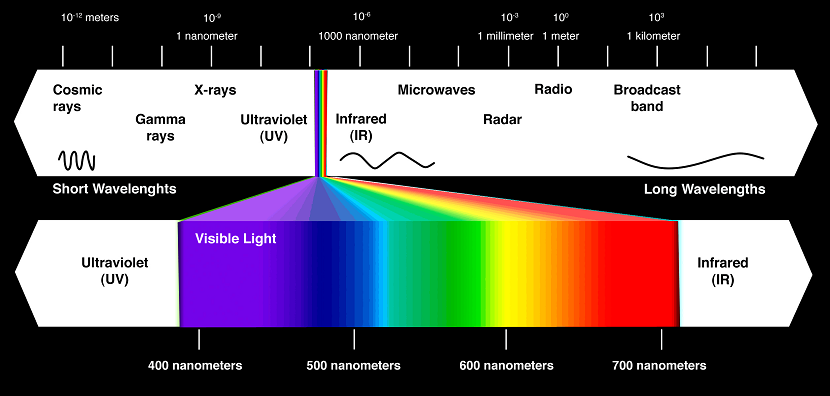
The above graphic goes from short wavelengths (left) to long wavelengths
(right).
The graphic below goes in the opposite direction. Both are correct.
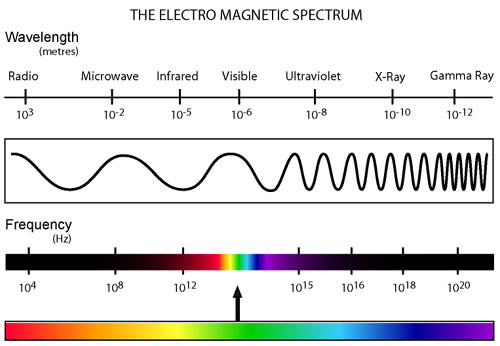
Energy Kids featuring Energy Ant: learn all about where we get our energy and how we use it. Loaded with facts, games, and activities. The Glossary explains every energy term you ever heard of.
Engineer Girl lets middle school girls find out more about careers in engineering. "Turn imagination into reality with a future in engineering! Engineering careers, women engineers, what to take in high school to get ready (hint: math & science), essay contest, Ask an Engineer, more. From The National Academy of Sciences.
Engineer Your Life "Welcome to Engineer Your Life, a guide to engineering careers for high school girls! Imagine what life would be like without pollution controls to preserve the environment, life-saving medical equipment, or low-cost building materials for fighting global poverty. All this takes engineering. In very real and concrete ways, women who become engineers save lives, prevent disease, reduce poverty, and protect our planet. Dream Big. Love what you do. Become an engineer." Videos of successful women engineers of various ethnic backgrounds expose girls to all they could do and be in the field. From The National Academy of Sciences. Thank you Shelly.
Engineering Interact is interactive science & engineering for 9-11 year olds. Play the games to learn about the physics of light, sound, forces, electricity, and the Solar System. Good loud and flashy games that make kids think. From the Department of Engineering at the University of Cambridge, UK, serving your educational needs since 1209 AD. (Sorry, boffins din't say which College...)
Exploring the Science of Light "This Web site is devoted to everything optics! You will find activities combining Jell-O and laser pointers, definitions of terms like acousto-optics and retroreflection, profiles of optics celebs who are changing our world and an optics timeline stretching from prehistory to the present. Don't forget to check out the tutorials featuring interactive applets and the sweet optical illusions!"
"The Falcon has landed" | Recap of Falcon 9 launch and landing, 3:37 video. "On December 21, 2015, SpaceX's Falcon 9 delivered 11 satellites to low-Earth orbit and landed the first stage of the rocket back on land." Watch this and see what that looked like!
![]() Fantastic
Contraption "A fun online physics puzzle game!" Build machines
to do 21 different tasks. Every user-built machine different. Teaches logic
and basic engineering principles. Thanks, Griz!
Fantastic
Contraption "A fun online physics puzzle game!" Build machines
to do 21 different tasks. Every user-built machine different. Teaches logic
and basic engineering principles. Thanks, Griz!
FIDGiT a fast-paced action thinking game that you can add onto! "DESIGNiT, BUILDiT, FIDGiT is an exciting puzzle game where you solve challenges and save tiny creatures called Fidgits! Think fast and manipulate blocks, springs, funnels, and other objects to bring the Fidgits home safely.
Features:
From Design Squad Nation, WGBH Boston.
Find the Technology - Computer Vocabulary from ABCya! Kids have to find various computer peripherals and digital equipment in a colorful workshop. Use the fewest possible clicks.
Flight site from NASA, for kids, with lesson plans for teachers. What is Aeronautics, History of Flight, Dynamics of Flight, Airplanes, Engines, and Fun & Games, including a learning game about the Wright brothers!
Foldscope: Microscopy for everyone Cheaply made yet precision sharp origami paper microscopes! These can be made available to everyone, be it in science classes or in clinics in developing countries. Constantly evolving, general use foldscopes, specialty foldscopes for disease detection and germ identification. This sites explains it all, with videos, galleries, tutorials, the original TED talk, and Microcosmos, where users can post their work!
Fraction to Decimal and Millimeter Table from HamUniverse "Convert fractions to decimals and millimeters and reverse." Nice! It comes with good, clear instructions.
Google Science Fair 2014 Winners There were seven prize winners this year, ages 14 - 17. The winners were Irish (team of 3), Canadian (1), Indian (1), and American (2). Some amazing scientific research was done, some similarly impressive engineering and coding, too. Every project can impact the world in ways great and small. Go and meet these winners. Maybe you'll be in it next year.
Grand Canyon from the Stratosphere! A Space Balloon Story "In June 2013, a group of friends launched a weather balloon a few miles from Tuba City, Arizona. The amazing footage was found two years later by an Arizona hiker. Enjoy the video of our launch preparations, video footage, and some data analysis of the flight." Here is the 4 minute YouTube video.
 The
Hanging Gardens of Babylon
The
Hanging Gardens of Babylon
(Article title = Breathtaking Animation Presents A Reconstruction Of The Hanging Gardens Of Babylon) This was one of Herodotus’ Seven Wonders of the Ancient World. "The folks over at Lumion 3D have given a go at virtually reconstructing this monument from antiquity – and the results are quite breathtaking to say the least". Three-minute video.
![]()
How an 18th
Century Sailing Battleship Worked
25 minute YouTube video.
"Fly through a wooden warship from the age of sail!"
Explore all the decks in detail. Learn about the complicated
ropes, sails, and rigging. See the different types of guns
and shells. Some of those ships held 1,000 men, and
everything was highly organized.
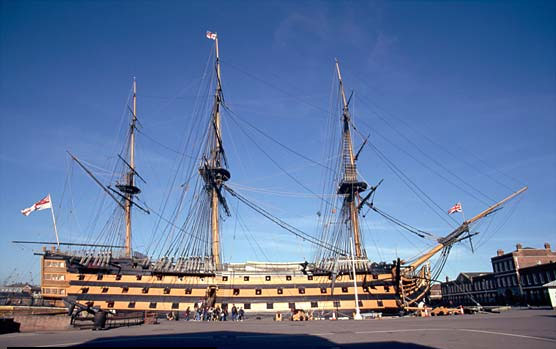
How to Create a Jeopardy-style Game in Google Spreadsheets "In the video embedded I demonstrate how to use Flippity to create a Jeopardy-style gameboard." Use it for any subject. Use it on an overhead such as Promethean.
Flippity.net Easily turn a Google™ Spreadsheet into a set of online flashcards. Easily turn a Google spreadsheet into a trivia game show.
![]()
HT
Science Moments Facebook site only. You'll have to go on
Facebook to access this site.
Features all kinds of STEM-related submissions, also some skippable ads.
Partial list from today: Physics Marble Tracks, Gravity Visualized, Tsunami
from the Sky, Gravity - Black Holes, Around The Corner - How Differential
Steering Works, Escape Velocity & the History of Space Travel, oodles
more!
The Helicopter Page An old-time Army pilot explains the principles of helicopter flight. He goes over the unique vocabulary, with graphics. He talks about what it's like to take off and land, and what is happening when you do. There's an explanation of jet engines, with graphics. He covers NOE ("nap of the earth") flying. There's a section on Autorotation and what the pilot should do. He expands into what military helicopters do on the battlefield. There's a page of tables with the specs on different helicopter types. He covers the V-22 Osprey and similar aircraft in great detail. Also, you will find out what the Jesus Nut does and why it has that name!
Helping With Horsepower™ Bike Rebuild Program "We work individually with each child to help them heal and most importantly, to help them find hope." "A different way of learning", kids build confidence, self-esteem, and teamwork skills that will serve them in life. They do it by rebuilding damaged motorcycles and raffling them off! Many kids need to move and to do things with hands instead of only doing classroom work. Read the article from Oprah:"I used motorcycles to teach them things I couldn't have otherwise," says Klock. "To challenge themselves, to work as a team." Klock's daughters—and her own troubled history—inspired her to start the Bike Rebuild Program. "If kids can learn to repair a damaged motorcycle," says Klock, "maybe they can also repair their lives." Read the article in IronWorks to see a completed motorcycle done by the young ladies of Abbot House. YFS/Girls Incorporated of Rapid City is rebuilding a 2012 Harley-Davidson Heritage Softail. The Rapid City Journal article says: "Girls to develop character by wrenching on a motorcycle...hopes that disadvantaged adolescent girls will learn to be strong, smart and bold, and learn they can overcome obstacles in their personal lives — all simply by wrenching on a motorcycle." Similar articles at KOTA-TV and KEVN TV.
![]() The
History and Future of Everything -- Time a video from Kurzgesagt
"Videos about Science, made with Love. We are a team of Information Designers
and Motion Designers that specialize in the art of explaining stuff." This
video gives kids a better understanding of time and history in proportion. Fine
graphics, nice music, wonderful narration. They have more videos, from evolution
to the stock market.
The
History and Future of Everything -- Time a video from Kurzgesagt
"Videos about Science, made with Love. We are a team of Information Designers
and Motion Designers that specialize in the art of explaining stuff." This
video gives kids a better understanding of time and history in proportion. Fine
graphics, nice music, wonderful narration. They have more videos, from evolution
to the stock market.
History of the Roman Colosseum 10 minute video quickly covers the history, starting with Vespasian's desire to replace Nero's vast "Golden House" complex with something for the people. Construction, layout, the retractable top, stairs, elevators, and restaurants! The early Coliseum was regularly flooded so that sea battles could take place. Nero's "plumbing" - tunnels for filling and draining - are explored. The Hypogeum was built later. All its fascinating parts are examined, even the elevators.
How an engine works - A comprehensive tutorial animation featuring Toyota engine technologies. This YouTube video (8 minutes) is simple and fairly easy to understand. The graphics are well done and easy to follow. It was designed to train new Toyota sales staff who don't know engines. Guess what? It works just fine for explaining auto engines to anybody! The first half is a basic description of modern auto engines. The second half gets more involved, but the technology is actually common to most makes. "If you use technology, you should know something of how it works."
How and Why to Teach Your Kids to Code This informative article from Lifehacker lists and discusses 10 free or inexpensive programs that will introduce kids to coding by letting them code. Scratch is on this list (hurray)! We've used Scratch with kids and they liked to play with it. Fun and colorful, Scratch is an MIT effort. Stencyl (Windows, Mac, Lunux; Free). "Stencyl is specifically designed to create games and can publish to every platform (iOS, Android, Flash, HTML5, Windows, and Mac). Over 12,000 games have been created using Stencyl." Stykz "the first multi-platform stick figure animation program in the world" is another fun coding program. You'll want to read "What We've Learned About Teaching Kids to Code" near the bottom of the article, too.
How an 18th Century Sailing Battleship Works
Fly through a wooden warship from the age of sail!

Exhaustive 25 minute Youtube video. It is
amazing what humans can make, within
the constraints of their current technology.
How canals work 0:54 video explains the idea of locks very simply.
How to build
an earthquake proof structure Watch as
traditionally built Chinese buildings
from the Forbidden City
ride out extreme earthquakes, just as they have done for
hundreds of years.
Find out how the old Chinese did it
in the Youtube video.
If 3 Little Girls Did This To My House, I'd Do Everything I Could To Get Them Full Rides To Stanford. "Fewer than 3 in 10 graduates in science, technology, engineering, and mathematics are women. And barely 1 in 10 actual engineers are women. Early in a girl's life, the toys marketed to her are usually things that don't encourage her to enter those fields. GoldieBlox intends to change that by teaching them while they are young that these fields can be fun — and apparently epic, by the looks of this super-genius 2-minute video. Watch and learn." OK, yes it's an ad for educational toys, and an internet hit. However, if these or similar toys, or becoming a Maker like young Sylvia, can up the percentage of little girls who grow up to be engineers, mathematicians, scientists, or technologists - then it's surely worth it.
Jacksmith You are Jacksmith, a traveling smith in a fantasy era. You specialize in crafting and forging weapons to fight monsters. Your clients are men-at-arms and angry peasants with axes, swords, shields, pikes, bow, staffs, and cannon balls. Add different pieces to make custom arrows. pikes. swords, etc. Your Jacksmith grows in knowledge of the smithing arts, both the business side and the forging side. Students gain knowledge of practical business math, inventory, planning, metallurgy, and situational awareness. Games can be saved, too.
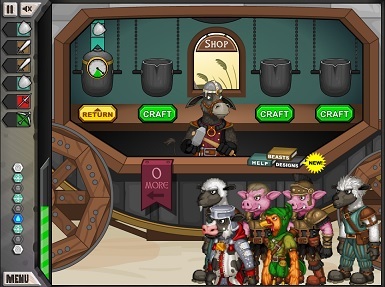
Japanese pagodas in earthquakes Pagodas never collapse. This Youtube video explains why.
Lessons In Electric Circuits "A free series of textbooks on the subjects of electricity and electronics." Excellent free learning, just bring a brain and the abilities to read and think. Consists of six online books: DC, AC, Semiconductors, Digital, Reference, and Experiments. Volume I starts with static electricity and ends with explanations of capacitors and inductors. It's free, it's good, and it's on the web.
Invention Smithsonian - Centerpieces Lemelson Center virtual exhibits and explorations. Find out about all sorts of famous inventions, from Edison to quartz watches and electric guitars! Invention at Play is the fun and interactive part for kids! There are four activities here, the two we like best are Puzzle Blocks and Tinker Ball. Both are challenging thinking games that are fun, too! Thanks, Bevin.
Zoom Inventors and Inventions Zoom does it again with yet another big collection of facts! Inventors & inventions indexed alphabetically, by time, by type, women inventors, Afro-American inventors, much more.
 Jmol:
(FREE!) "an open-source Java viewer for
chemical structures in 3D, with features for chemicals, crystals, materials
and biomolecules."
Jmol:
(FREE!) "an open-source Java viewer for
chemical structures in 3D, with features for chemicals, crystals, materials
and biomolecules."
Jmol is an interactive web browser applet. Overview:
Learn an Hour of Code from Code.org "3,662,409 have learned an HOUR of CODE Anybody can learn." This page is being promoted by everyone from "Apple to Zuckerberg". We've seen related pages in different languages, from Chile to Sri Lanka. There are fun tutorials teach anyone to code by making Holiday cards, Build your own Game, the MIT App-Inventor that teaches how to make a working app, and LightBot Any one of which will teach an hour of code, and kids won't even notice they're learning. Some are for any age, others for middle school and up (it says here). If anyone wants more (hope), there is a big section on Javascript, another on Python, even one using pencil and paper! Yes, and teacher guides as well. If you are too late to participate in Hour of Code Week, this site will be around for awhile.
 Lock
Simulation by David Waiengnier, from Pragma-Soft. Click the Union Jack
(British flag) to do this activity in English. Operate the locks on a virtual
canal, moving boats downstream and upstream! Learn what to do 1st, 2nd, and
last. Watch for alarms. Learn about sequences. Enjoy watching the boats going
up and down. Kids will remember this.
Lock
Simulation by David Waiengnier, from Pragma-Soft. Click the Union Jack
(British flag) to do this activity in English. Operate the locks on a virtual
canal, moving boats downstream and upstream! Learn what to do 1st, 2nd, and
last. Watch for alarms. Learn about sequences. Enjoy watching the boats going
up and down. Kids will remember this.
![]() Logism
"An educational tool for designing and simulating digital
logic circuits, featuring a simple-to-learn interface, hierarchical circuits,
wire bundles, and a large component library. As a Java application, it can run
on many platforms. " "Excellent tool for learning, simple and effective."
"Logism is an excellent tool for exploring how digital circuits work and
makes for a tremendously useful teaching aid." This excellent GNU General
Public License (GPL) free download
comes courtesy of sourceforge.net. Small download - 6.6
Mb.
Logism
"An educational tool for designing and simulating digital
logic circuits, featuring a simple-to-learn interface, hierarchical circuits,
wire bundles, and a large component library. As a Java application, it can run
on many platforms. " "Excellent tool for learning, simple and effective."
"Logism is an excellent tool for exploring how digital circuits work and
makes for a tremendously useful teaching aid." This excellent GNU General
Public License (GPL) free download
comes courtesy of sourceforge.net. Small download - 6.6
Mb.
Logicly * is an online interactive logic gate simulator. Lets kids build their own logic setups to see what happens. Start with simple AND & OR gates and try to make the bulb light up, work up to complicated projects (for kids) like adders. This teaches logic and shows how the various gates work. Instructions: Click and drag components onto the work space. Click on the circles on components and drag the mouse to another component to create wiring. Turn the simulation off and on in the lower right corner of the workspace. To remove a component, click on it and the press the keyboard Delete button. Reload the page to clear the entire workspace if you need to. "Logicly simulates the boolean algebra performed by logic gates, which are a vital part of digital circuitry and computer achitecture." * This is now a commercial educational app. There is a 30 day free trail ready for downloading. Pricing link here.
Made with Code Google is launching Made w/ Code, a program to encourage girls to learn to program and possibly pursue careers in computer science. Made w/ Code is "a social initiative to create a coding culture for girls based on creativity and making. Made with Code will strive to inspire millions of girls to experience the power of code. The goal is to demonstrate how coding can help them to pursue, and reach, their dreams." Less than 1% of high school girls express interest in majoring in computer science. "Coding gives you the power to create and invent things that could help millions of people with your ideas; sadly we’ve seen that bias and stereotypes are keeping most teenage girls from expressing interest in learning to code. We're launching Made with Code to inspire millions of girls to experience the power of coding and to see it as a way to have fun and achieve their dreams," said Megan Smith, vice president, Google. GSFK thinks this is a good idea.
Code.org (Remember the Hour of Code?) also offers a K-8 Intro to Computer Science Course (15 - 25 hours) online. It looks well worth trying in classrooms.
![]()
This is a type M777
155mm towed howitzer.
Its name is Britney.
It can easily hit targets 18 - 25 miles away depending
on the type of round being fired.
The crew feeds 46-48Kg (103-106 pound) shells to Britney.
Then they aim, fire, and reload Britney.
Women can do anything they set their minds to.
MIT+K12 Videos "Original Webseries From MIT Showcasing Real Science & Real Scientists. Served Up Fresh From The Heart Of Innovation & The Big Bang Of Great Ideas." Various YouTube playlists cover anything from 8th graders tie dying milk and making lava lamps, how braces work, why we can't regrow limbs, what is a semiconductor, why we fart, how ships float, and why is there snot? (This is a small sampling, mostly from Science Out Loud)
This ever evolving video resource is free! Lucky us!
MIT App Inventor jumps right into tutorials on how to make Android Apps! Yes, there is also a Teacher Section with lesson plan ideas. Learn to write good apps and maybe get rich!
What's the Best Language for a Beginning Programmer? an op-ed piece from Popular Mechanics Online, gives ideas on what language a secondary school beginner should start with. Java, Scratch (kids love Scratch), Alice, MVB, C++, Python, and App Inventor are covered and various opinions expressed about each.
Map Stack by Stamen. “Map Stack is about putting your creativity on the map, making it radically simpler to design your own map styles, without having to know any code, sign up for anything, install any software, or do any typing.” (from GOOD) Assemble a selection of different map layers like backgrounds, satellite imagery, terrain, roads or labels! Tweak Photoshop-like controls like colors, masks, opacity and brightness to make a map your own! Share your map with a link or Pinterest or Tumblr!
Margaret Hamilton developed on-board flight software for the Apollo space program. Software designer, systems engineer, businesswoman. Invented new paradigms for coding that vastly increase the reliability of software. Designed Universal Systems Language (USL).

![]()

![]()
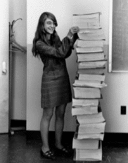 < That is a stack of code, students! Back
in her day (1960's) there were no monitors,
no hard drives, and 8"
tape reels for storage! You had to run a program to see if it worked!
This was a major incentive in
the quest to develop better software! Which she did. Read the Wikipedia article.
< That is a stack of code, students! Back
in her day (1960's) there were no monitors,
no hard drives, and 8"
tape reels for storage! You had to run a program to see if it worked!
This was a major incentive in
the quest to develop better software! Which she did. Read the Wikipedia article.
Metric Conversion & Metric System Easy and concise, this site does interactive metric to US conversions for: length, weight (mass), temperature, area, volume/capacity, mileage, enegy, force, and power! There are also tables giving equivalent volume, area, mass, and length values. There are explanations of weight vs. mass, and how to do temperature conversions. Excellent reference and help site!
Moving
sculptures on the beaches of The Netherlands Amazing! Must see to Believe!
Kinetic sculptures made of "electrical tubes" and zip ties that
walk along the beach!
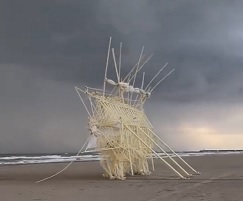
NASA
Dawn mission infographic All about the Dawn mission, the spacecraft, and
its mission to Vesta and Ceres.
Brought to us via Space.com
Navigation Education Materials Ten middle school science lesson plans ready to go! These teach navigation, mapping, topo maps, GPS, and space navigation! Excellent introduction to a technical subject. From the renowned Institute of Navigation. Because we need to educate kids in important technical subjects.
New
Horizons encounter with Pluto All about the flyby and what the spacecraft
discovers.
Presented by Space.com
Oil Refineries from Moorland School is getting its own page because kids need to know how we get gasoline (petrol), oil, asphalt, diesel, kerosene, etc. Good easy explanation with a good diagram.
![]() Packetville
About time we got a kid-friendly site about the mechanics of the internet!
These fun games and related activities help kids learn how the internet works.
Peter Packet Server, Router, and Wireless Space games let kids move their
data packers around the internet to help kids in Third World countries, while
fighting viruses and rebooting routers on the way. Example: moving information
to help Haitian kids get clean water. Kids learn a lot about the internet
and conditions in impoverished areas at the same time. Packet Riders for ages
8-11 and Hacker Busters for ages 12-14. Also has instructional materials for
educators. You can play online or download the games. Requires Shockwave.
Also features "Career Capture - This is the place to meet some smart
women who understand how technology unlocks the door to very cool careers.
Explore their stories and create your own scrapbook!" (.exe file, BIG
download of 145Mb) Free to you from Cisco, one of the biggest internet outfits.
Found by Mattie., former coworker.
Packetville
About time we got a kid-friendly site about the mechanics of the internet!
These fun games and related activities help kids learn how the internet works.
Peter Packet Server, Router, and Wireless Space games let kids move their
data packers around the internet to help kids in Third World countries, while
fighting viruses and rebooting routers on the way. Example: moving information
to help Haitian kids get clean water. Kids learn a lot about the internet
and conditions in impoverished areas at the same time. Packet Riders for ages
8-11 and Hacker Busters for ages 12-14. Also has instructional materials for
educators. You can play online or download the games. Requires Shockwave.
Also features "Career Capture - This is the place to meet some smart
women who understand how technology unlocks the door to very cool careers.
Explore their stories and create your own scrapbook!" (.exe file, BIG
download of 145Mb) Free to you from Cisco, one of the biggest internet outfits.
Found by Mattie., former coworker.
Physical Constants for Fire Investigators. This a forensics site from Australia. It's valuable to teachers and students who need to know: flame colors, melting points and ignition temperatures of different plastics, metals (melting points), liquids (boiling points, flash points, ignition temperature, and heat of combustion in kcals/gram), gases (flammable limits, ignition temperature). Special sections for steel, concrete, glass, and house insulation. Good for physics and chemistry, among other things. BTW all temps are in Celsius.
Pigments through the Ages "Pigments are the basis of all paints, and have been used for millennia. They are ground colored material. Early pigments were simply as ground earth or clay, and were made into paint with spit or fat. Modern pigments are often sophisticated masterpieces of chemical engineering. This exhibit includes most important pigments used through the early 20th century." Explore timelines, a pigment catalog, history of different colors, different artist paints, how to mix paint, make your own painting, etc. One of many sites at WebExhibits.
s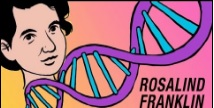
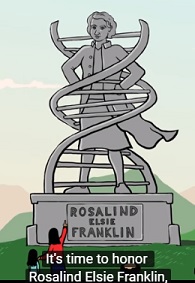
Rosalind Franklin: DNA's unsung hero, by Cláudio L. Guerra. From TED-Ed Original Lessons. "The discovery of the structure of DNA was one of the most important scientific achievements in human history. The now-famous double helix is almost synonymous with Watson and Crick, two of the scientists who won the Nobel prize for figuring it out. But there’s another name you may not know: Rosalind Franklin. Cláudio L. Guerra shares the true story of the woman behind the helix." She did the work and they got the credit (you know, sexism). In this case, outright theft was involved. "Somebody" stole Dr. Franklin's work and used it to figure out the double helix.
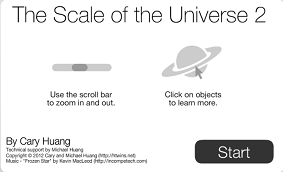
The Scale of the Universe 2 From PolicyMic: "Most of us have trouble visualizing the height of buildings, or the distance it takes to get home from work, let alone things on an intergalactic scale. The interactive graphic made by 14-year-old Cary Huang may be the best tool to help us understand our place in our vast universe. The interactive piece allows the viewer to zoom through scale and space, from quarks to galactic clusters. The real genius of the interface is the ability to scroll back to a familiar object like a car — the time spent scrolling helps to convey a sense of size and distance." You can find out more about objects displayed by clicking on them. You can find out more about the Huang brothers here.
Science
at work - The LifeStraw. Article is from IFLS
The LifeStraw removes at least of 99.99999% of waterborne bacteria and 99.9%
of waterborne protozoan parasites. It can filter up to 1000L of water.
Throughout the world, an estimated 884 million people still do not have access
to clean sources of water. This device contains no chemicals or batteries
and makes it possible to drink safely from any river, lake or puddle.
Buy them here: bit.ly/1YbTja9
For every unit sold, two children in the developing world will be supplied
with clean drinking water for a year.
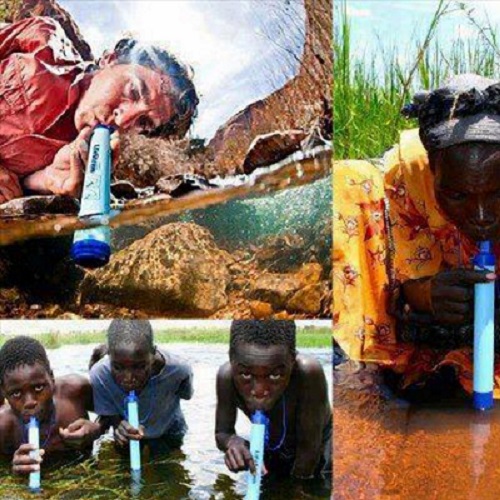
Science: It's A Girl Thing | Facebook "Welcome to the official Facebook Page of Science: It's A Girl Thing. Get exclusive content and interact with Science: It's A Girl Thing right from Facebook." Four downloadable .pdf good and easy science activities for kids, more will be added later. There are also videos of three of the activities being done with kids. This is a work in progress so keep checking back.
 Scratch
is a free programming language primarily for 8 to 16 year olds. It has an
online community where kids can program and share interactive media such as
stories, games, and animation with others from all over the world. As children
create with Scratch, they learn to think creatively, work collaboratively,
and reason systematically. Scratch is a project of the Lifelong Kindergarten
Group at the MIT Media Lab. It is provided free of charge. Find out more by
clicking on the cat!
Scratch
is a free programming language primarily for 8 to 16 year olds. It has an
online community where kids can program and share interactive media such as
stories, games, and animation with others from all over the world. As children
create with Scratch, they learn to think creatively, work collaboratively,
and reason systematically. Scratch is a project of the Lifelong Kindergarten
Group at the MIT Media Lab. It is provided free of charge. Find out more by
clicking on the cat!
 ScratchEd
What is ScratchEd? ScratchEd is an online community where Scratch
educators share stories, exchange resources, ask questions, and find people.
Since its launch, more than 7500 educators from all around the world have
joined the community, sharing hundreds of resources and engaging in thousands
of discussions. Join the ScratchEd community for free at scratch-ed.org.
ScratchEd
What is ScratchEd? ScratchEd is an online community where Scratch
educators share stories, exchange resources, ask questions, and find people.
Since its launch, more than 7500 educators from all around the world have
joined the community, sharing hundreds of resources and engaging in thousands
of discussions. Join the ScratchEd community for free at scratch-ed.org.
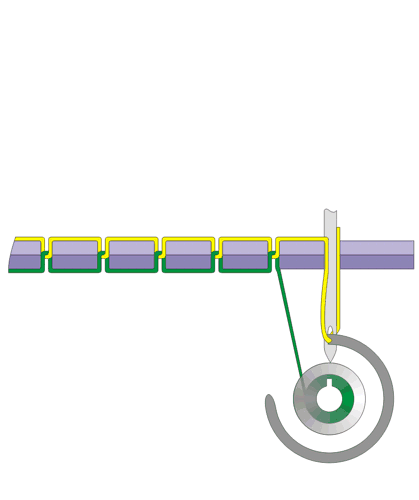 Just
in case you were wondering how a sewing machine works.
Just
in case you were wondering how a sewing machine works.
 Should
a person touch 200,000 volts? "What happens if a person touches 200,000
volts? Should a person even be touching 200,000 volts in the first place?
Find out in this live Van de Graaff generator experiment!" Eight minute
video from Jefferson
Lab via ScienceDump
Should
a person touch 200,000 volts? "What happens if a person touches 200,000
volts? Should a person even be touching 200,000 volts in the first place?
Find out in this live Van de Graaff generator experiment!" Eight minute
video from Jefferson
Lab via ScienceDump
![]()
Simple Machines subsection
The Elements of Machines - from The Inventor's Toolbox, The Museum of Science, Boston. Part of a section on Leonardo da Vinci. Explains five Simple Machines: wheel and axle, pulley, wedge, screw, and lever. Other Elements of Machines explains how the simple machines can be combined and modified to produce: gears, bevel and worm gears, rack and pinion, cam, crank and rod, chains and belts, and the ratchet. Students can use this information to understand the machine elements of various tools. Gadget Anatomy This page lets students check their understanding by working out the machine elements of several hand tools. "Look carefully at each tool. Think about how each part moves and makes the other parts move as the tool does its job. Which elements of machines do you see in each gadget? Click on only the ones you see."
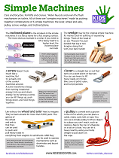 Infographic:
Simple Machines Cars and bicycles. Forklifts and cranes. Water faucets
and even the flush mechanism on toilets. All of these are “complex machines”
made by putting together combinations of 6 simple machines. Teach students
about the lever, wheel and axle, pulley, screw, wedge, and inclined plane
with this free downloadable lesson sheet on simple
machines, perfect for the classroom or home. This free
Vocabulary
Packet for Kids Discover Simple Machines will help you teach kids core
vocabulary related to physics, by examining the simple machines such as wheels,
pulleys, planes and levers that run our lives. This free
Lesson
Plan for Kids Discover Simple Machines will help you teach kids
core concepts related to physics, by exmaining the simple machines such as
wheels, pulleys, planes and levers that run our lives.
Infographic:
Simple Machines Cars and bicycles. Forklifts and cranes. Water faucets
and even the flush mechanism on toilets. All of these are “complex machines”
made by putting together combinations of 6 simple machines. Teach students
about the lever, wheel and axle, pulley, screw, wedge, and inclined plane
with this free downloadable lesson sheet on simple
machines, perfect for the classroom or home. This free
Vocabulary
Packet for Kids Discover Simple Machines will help you teach kids core
vocabulary related to physics, by examining the simple machines such as wheels,
pulleys, planes and levers that run our lives. This free
Lesson
Plan for Kids Discover Simple Machines will help you teach kids
core concepts related to physics, by exmaining the simple machines such as
wheels, pulleys, planes and levers that run our lives.
See Microbes with this DIY Phone Microscope Pretty cool and fast, too. Smartphone + laser pencil lens = microscope! Record what you see on your phone! This page has several other cool things to read about, too.
Simple Machines "Learn about simple machines and the forces that make them work." One of several online activities from the Center of Science and Industry (COSI) in Columbus, Ohio. This activity is a Flash file. This activity is one of the best we have seen in a long time. Three sections introduce simple machines, explain mechanical advantage, show examples of kinds if simple machines. Students should go over them carefully because they need to know the math facts in order to advance through the sections. This is for middle school and up, maybe 5th graders with good guidance.
Simple Machines Great basic simple machines site from EdHeads. Has animation, sounds, and very good interactive activities.
Simple Machines from Kidepede's big Physics section. One-page explanations of the six simple machines using simple language and graphics. There are links to activities for each simple machine.
Simple Machines web page from Kennesaw State University of Georgia. This is a list of links to good sites that cover simple machines, online and offline activities, printouts, and lesson plans. A good resource for busy teachers.
Simple Machines Spotlight. Franklin Institute's simple machines page. Good explanations and some activities, too.
Soldering Basics and "The Ten Commandments" For Electronic Soldering These are two sequential pages from the same site. With the Maker phenomenon in full swing, there is a need for helpful tips like these. Kids should not solder without supervision. Adults who have never soldered (and kids) need to know these tips.
Space Sciences from the Office of Naval Research, USN. There are two main sections, Observing the Sky and the Solar System, covers basic introduction the various sections of astronomy and have tons of information. The Navy & Satellites includes satellite launch trajectories, orbits, and how GPS works.
![]()
STEMware:
Zombie Plague from the Partnership for Biotechnolgy and
Genomics Education, University of California - Davis. " In STEMware:
Zombie Plague, students explore a 3D world where they are responsible for
identifying the pathogenic microorganism causing a deadly outbreak and implementing
a cure... the science content embedded in the software deals with diagnosis,
treatment strategies, and career connections that are applicable to any disease
caused by viruses, bacteria or fungi. Interactions with characters in-game,
introduce students to the variety of career pathways in modern biology along
with diagnostic technologies used in the real world. Embedded assessments
allow teachers to track student interactions." Kind of a mix between
a James
Patterson game and Edheads. Download
the game here,
or use the Curriki link above. It's a 305mb .zip file, so we suggest you save
the file on a flash drive for installs on more machines.
 Stonehenge
Panorama 3-D panorama in Shockwave, taken from the center of 4,500 year
old Stonehenge. Scroll around and see what it looks like! Think of the planning
and engineering that went into building this without the help of modern machinery.
Read about the hidden
archaeology of Stonehenge, the discovery of a huge complex of ancient
sites under the area. It turns out Stonehenge was just one part of this huge
temple!
Stonehenge
Panorama 3-D panorama in Shockwave, taken from the center of 4,500 year
old Stonehenge. Scroll around and see what it looks like! Think of the planning
and engineering that went into building this without the help of modern machinery.
Read about the hidden
archaeology of Stonehenge, the discovery of a huge complex of ancient
sites under the area. It turns out Stonehenge was just one part of this huge
temple!
Stunning Aurora Borealis from Space in Ultra-High Definition (4K) super cool five minute video from NASA. "The auroras, or polar lights, are basically natural light shows. They are seen mainly in the Arctic and Antarctic regions and are created when electrically charged electrons and protons in the Earth's magnetic field smash into the neutral atoms found in the upper atmosphere. This produces bright, eerie lights that streak across the sky. The NASA video shows the ghostly polar auroras hovering over the planet with an iridescent green glow."
Stunning 3D Animations Showcase The Internal Layout Of The Roman Domus (House) "... a typical Roman domus served as a dwelling for the Roman familia, while being (sometimes) used as a ‘personalized’ center for business and religious worship." A domus was designed for "higher middle class Roman citizens", when those people were not living at a villa at their country estate. This animation takes you through the house and grounds, and the article shows blueprints and explanations, too. "The resourceful folks over at Ancient Vine and Museum Victoria have given a go at virtually reconstructing the typical Roman domus of a ‘well-to-do’ family."
The second video "showcases the Roman domus of Domitia Longina, wife to the Roman Emperor Domitian, who lived from 55-126 AD. Suffice it to say, the house was bigger than the typical Roman domus, and as such also consisted of a thermae – a bathing facility specifically constructed within the compound of the residence." Superb animation and music.
The third video, Ancient Roman Homes of the Rich, is narrated. Everything important is labelled, in Latin. This video covers things not often discussed in these short videos, such as water, plumbing, radiant heating, baths, the various entrances, dining, and bedrooms. ©2014 David Egan Productions.
Sunstones! - Shipwreck Discovery May be Fabled Sunstone - what is it?The Alderney Crystal was originally transparent, but the sea water had turned it a milky white.
![]()
Sylvia's Super
Awesome Maker Show! "Sylvia's DIY webshow on everything cool
and worth Making." At GSFK we are fond of Do It Yourself and we'll always
post a good DIY for kids site, like this one. Young Miss Sylvia hosts an online
show that, among other things, has (as of November 2012) 19 great DIY crafty
videos. Good instructions, good kid humor, and the whole family helps out.
Sweet and awesome at the same time.
Sylvia at the White House! Awesome Maker Sylvia of Sylvia's Super Awesome Maker Show! went to the 3rd Annual White House Science Fair, showed off her WaterColorBot paint pen plotter to President Obama (he tried it out) and was interviewed by Bill Nye the Science Guy and Levar Burton! There are videos of this, too. (We posted Sylvia's site back in November 2012) We wish this young lady and her family all the best! Kids, if your talents run in this area and you feel alone, do not be discouraged, but find local groups for Makers.
Technology from Extreme Science. The techno section of the larger site.
Technology and Social Science from SCORE History/Social Science is a whole section on technology integrated into Social Science - with its own lesson plans and ideas for teachers!
This Is What It’s Like To Be A Girl Who Codes "This video tells the story of 5 young app developers on their journey to Apple’s Worldwide Developers Conference in San Francisco." Age range is 12 to 19, and the 12 year old has an excellent app! They met Tim Cook, too. Code Like A Girl is their YouTube video, if you're in a hurry.
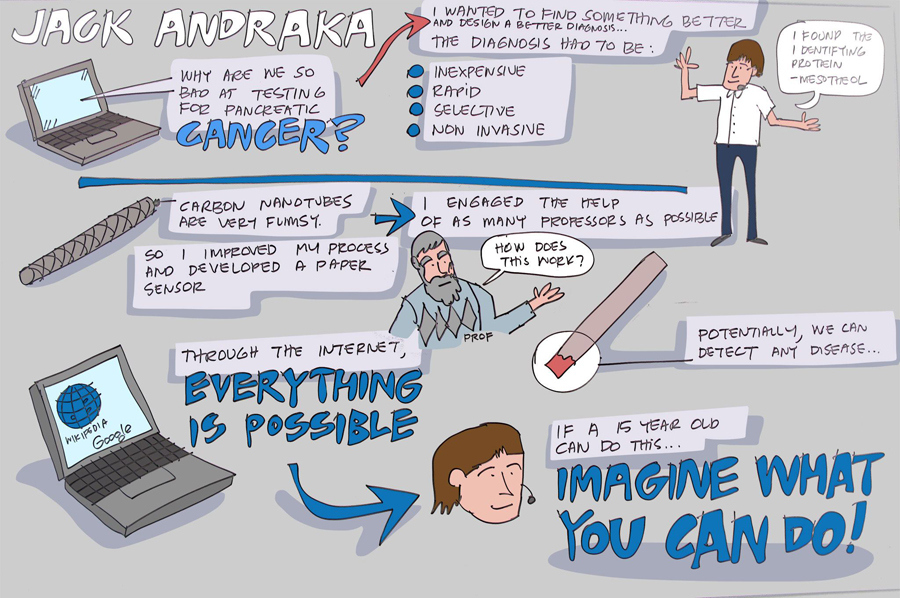
This
15-Year-Old Kid May Have Just Saved Your Life is the name of an article
on Crooks & Liars * about Jack
Andraka, who has invented a new test for pancreatic cancer that is "168
times faster, over 26,000 times less expensive and over 400 times more sensitive.
And what I found is that my sensor in a blind study it actually had a 100%
correct diagnosis, in diagnosing pancreatic cancer and could diagnose the
cancer before it actually became invasive." We hope this example inspires
many other young people to believe in themselves, and to do some creative
tinkering for the benefit of all of us. Comes with a video. (*The name of
the e-zine does not reflect on the veracity of the article.)
Addendum: "Jack
Andraka has created a pancreatic cancer test that is 168 times faster and
considerably cheaper than the gold standard in the field. He has applied for
a patent for his test and is now carrying out further research at Johns Hopkins
University in the US city of Baltimore.
And he did it by using Google.
The Maryland native, who won $75,000 at the Intel International
Science and Engineering Fair in May for his creation, cites
search engines and free online science papers as the tools
that allowed him to create the test." (credit: insideofiran.org)
You Don't Know Jack A video by Morgan Spurlock. This is a 3:34 Vimeo video about Jack Andraka, who we posted about earlier this year. "Jack Andraka, a high school sophomore, has developed a revolutionary new test for pancreatic cancer." The video covers his struggles to find lab space, 199 rejection letters, a non-supportive family. The scientific establishment did't want to hear new ideas from an 8th grade. With the help of a good teacher, Jack persisted, and finally got lab space. The rest is, and will continue be, history. Give the kids a chance!
Touchstone Energy Kids Zone"a cool place where you can learn about electricity, energy savings and electrical safety. Energy is part of our daily lives. Every time you watch television or turn on a light you are using electricity. Here at the Touchstone Energy Kids Zone we have some fun games and activities that will help you learn about energy and energy efficiency. We have lots of information you can share with your family and friends." Pretty good site, with easy explanation of electricity transmission, how to save electricity, games and activities for kids, and a Teacher Zone.
Untangling the web: how spiders use their silk Very informative and colorful graphic from, and owned by, The Guardian. It turns out spiders have six different silk glands that make six different kinds of silk for six different purposes.
Virtual hip replacement
surgery "Take on the role of the Surgeon throughout a hip replacement
surgery! Grades 7- 12+" Includes Teacher's Guide, Teacher Resource Center,
Glossary, and Videos.
![]()
Virtual knee replacement
surgery "Take on the role of the Surgeon throughout a total
knee replacement surgery! Grades 7- 12+" Includes Teacher's Guide, Teacher
Resource Center, Glossary, and Videos.
![]()
![]() The
Virtual Microscope from University of Illinois. Oh you've got to get this
for kids! Amazing closeups! Plug in a digital projector and show these on
the wall! "The Virtual Microscope is a NASA-funded project that provides
simulated scientific instrumentation for students and researchers worldwide
as part of NASA's Virtual Laboratory initiative. This site serves as home
base for the Imaging Technology Group's contributions to that project—namely
virtual microscopes and the multi-dimensional, high-resolution image datasets
they view. Currently we provide 90 samples totaling over 62 gigapixels of
image data. The Virtual Microscope, which is available for free download supports
functionality from electron, light, and scanning probe microscopes, datasets
for these instruments, training materials to learn more about microscopy,
and other related tools. The project is open source and the code is available
on Sourceforge." More info at the site. Note: This program requires Java.
The
Virtual Microscope from University of Illinois. Oh you've got to get this
for kids! Amazing closeups! Plug in a digital projector and show these on
the wall! "The Virtual Microscope is a NASA-funded project that provides
simulated scientific instrumentation for students and researchers worldwide
as part of NASA's Virtual Laboratory initiative. This site serves as home
base for the Imaging Technology Group's contributions to that project—namely
virtual microscopes and the multi-dimensional, high-resolution image datasets
they view. Currently we provide 90 samples totaling over 62 gigapixels of
image data. The Virtual Microscope, which is available for free download supports
functionality from electron, light, and scanning probe microscopes, datasets
for these instruments, training materials to learn more about microscopy,
and other related tools. The project is open source and the code is available
on Sourceforge." More info at the site. Note: This program requires Java.
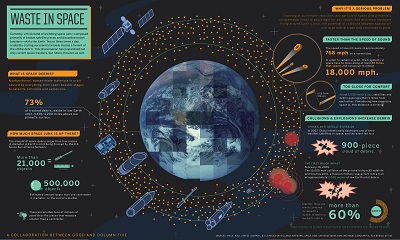 Waste in Space Infographic details
the growing menace of leftovers in orbit. Two to three times a day, a satellite
has a brush with death from kamikaze space debris. 1,000 times a day, satellites
come within five miles of being hit. Learn all about it by reading this great
big (1600 X 900) graphic.
Waste in Space Infographic details
the growing menace of leftovers in orbit. Two to three times a day, a satellite
has a brush with death from kamikaze space debris. 1,000 times a day, satellites
come within five miles of being hit. Learn all about it by reading this great
big (1600 X 900) graphic.
We Choose The Moon is an interactive
experience recreating the historic Apollo 11 mission to the Moon in real time.
Once where only three men made the trip, now millions can. Live event begins
8:02 AM EDT July 16, 2009, with launch at 9:32 a.m., exactly 40 years after
Apollo 11 lifted off.
Webwise Computer Tutor from the BBC. " Welcome to Computer Tutor. I'll show you how to use a mouse, keyboard and computer screen." We know an awful lot of elementary age girls who are becoming addicted to this excellent, patient, interactive, kid-friendly site, and we're glad they showed it to us! Kids really do learn a lot about how to work a computer. The BBC does it again.
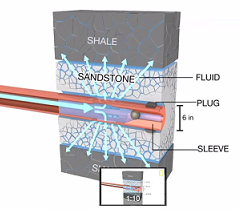
What Is Fracking? This 2:10 video from NatGeo does a good job of using animations of an actual well to explain fracking. Watch and learn.
Why
We Desperately Need To Bring Back Vocational Training In Schools
Thanks, Forbes! We at GSFK have been saying this for years. Article by Nicholas
Wyman.
Bring back shop classes! Before the 1950s, everybody took shop classes in
high school.
Now high schools are college-prep. There is nothing for those who learn in
other ways.
Take the time to read this two-page article, it's worth it.
"Just a few decades ago, our public education system provided ample opportunities
for
young people to learn about careers in manufacturing and other vocational
trades.
Yet, today, high-schoolers hear barely a whisper about the many doors that
the vocational
education path can open. The “college-for-everyone” mentality
has pushed awareness of
other possible career paths to the margins. The cost to the individuals and
the economy
as a whole is high. If we want everyone’s kid to succeed, we need to
bring vocational
education back to the core of high school learning.
The Year’s Best Art and Creativity Books for Kids from Tinkerlab. "Creative Experiments for Young Innovators... Tinkerlab supports parents and teachers who want to raise confident and creative thinkers, through child-directed and process-oriented projects. We’re so glad you’re here!" Click here to learn more. Oodles of projects in outdoors, art, science, sensory, upcycling, tinkertots, baby, toddler, and school-age. So when this site has a list of 12 top art and creativity books, it is worth reading. Teachers and parents, go read over this list, you'll be glad.
![]() to top of page
to top of page ![]()
![]() to Good Sites
to Good Sites
Morse Code and Cryptology section
CryptoKids™ America's Future Codemakers & Codebreakers. This is an educational site from the NSA. "Welcome to the NSA/CSS Kids’ page. We’re the CryptoKids and we love cryptology. What’s cryptology? Cryptology is making and breaking codes. It’s so cool. We make codes so we can send secret messages to our friends. And we try to figure out what other people are writing about by breaking their codes. It’s a lot of fun."
Morse code from Kids.net.au, an excellent Australian internet gateway. Online encyclopedia entry covers the basics.
Morse Code And Radios: A Guide For Kids and Amateurs "...educating kids on Morse code and their radio skills." This site covers:
Each section above includes links to other sites for further explanation.
Morse Code Cryptography lesson plan from Kids Kreate. Use spelling lists to learn and practice Morse Code.
Morse Code Messaging lesson plan from education.com.
Why is Morse Code Still Used? Short article explains the technical, economical, and cultural advantages of Morse code ("CW"). Also introduces QRP (" low powered stations"). "Morse code remains the simplest and most efficient way known to send messages via radio." It cuts through interference and is easier for non-English speakers to understand. Reasons to Continue using Morse Code restates the advantages of Morse code in a different way.
![]() to top of page
to top of page ![]()
![]() to Good Sites
to Good Sites
You can have your ol' "Technology". Just give
me my squeaky ball!
Powered by ![]() World's #1 Web Host
World's #1 Web Host